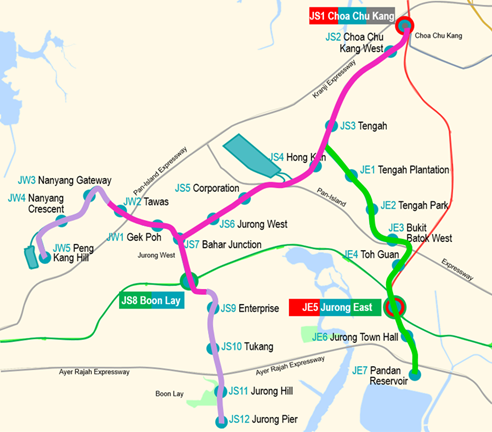Jurong Region Line: Enhancing Connectivity in the West


1. The Land Transport Authority (LTA) is pleased to announce the alignment and station locations for the seventh MRT line in Singapore, the Jurong Region Line (JRL). The JRL will be an elevated MRT line, which will serve existing and future developments in the western part of Singapore, and support the making of Jurong into an attractive place to work, live, learn and play.
2. The JRL will serve residents of Choa Chu Kang, Boon Lay, Jurong, and future developments in the Tengah area. It will also connect to main activity nodes in Jurong, such as the Jurong Industrial Estate, Jurong Innovation District, and the Nanyang Technological University (NTU). The JRL will also serve the Jurong Lake District, supporting plans to transform the area into Singapore’s western business district.
3. The JRL was first announced in the Land Transport Master Plan 2013, as a 20-kilometre long line opening around 2025. Following detailed engineering studies, the JRL will now be 24-kilometre long and will feature 24 stations, including three interchange stations at Boon Lay, Choa Chu Kang and Jurong East MRT Stations.
4. The construction of the JRL viaducts and stations will involve the diversion of major utilities and services, as the alignment is mostly along existing roads. As additional time is needed to complete the diversion works before the commencement of construction, the JRL will open in three stages starting 2026:
a. Phase 1 (2026): JRL (West) comprises 10 stations linking Choa Chu Kang to Boon Lay and Tawas;
b. Phase 2 (2027): JRL (East) comprises seven stations providing connection between Tengah and Pandan Reservoir; and
c. Phase 3 (2028): Extensions into NTU in the west and Jurong Pier in the south, completing the JRL (West) route.

Better Connectivity & Improving Resilience of the Rail Network
5. The JRL will improve connectivity in the western part of Singapore, by serving areas that currently do not have direct links to the rail network such as NTU, Jurong Industrial Estate, Jurong Innovation District, Pandan Reservoir and the future Tengah area. The stations at Choa Chu Kang, Boon Lay and Jurong areas are expected to add more than 60,000 additional households within a 10-minute walk from a train station. As key residential areas such as Tengah new town develop over time, even more households will benefit from the JRL in time to come.
6. The JRL will shorten travel times within the western part of Singapore (see Annex A). For instance, a commuter staying in Woodlands and working in Jurong Island will be able to reach Jurong Island Checkpoint in 45 minutes, which is 35 minutes faster than the 80-minute journey on public transport today.
7. The JRL will also improve the resilience of the rail network and provide commuters with alternative travel routes. By connecting to Choa Chu Kang and Boon Lay MRT Stations on the North-South and East-West Lines, commuters travelling from the northern region of Singapore will be able to access the Jurong region using the JRL, without going through the heavily-used Jurong East MRT Station.
8. The JRL is expected to serve more than 200,000 commuters daily in the initial years. This figure would rise to more than 500,000 when the Jurong Innovation District, Tengah area and Jurong Lake District are fully developed. As with the introduction of other new rail lines, LTA will review the bus services in surrounding areas to optimise connectivity to JRL and the rest of the rail network.
9. The JRL will be supported by an integrated rail and bus depot in the Tengah area. The rail depot will house the Operations Control Centre and provide stabling and maintenance facilities for about 100 JRL trains. In addition, there will be a stabling facility near Peng Kang Hill Station to further enhance the launching and withdrawal operations of trains instead of relying solely on the main depot. A multi-storey bus depot is co-located with the JRL depot to optimise land use and streamline construction processes. It will house the Bus Operations Control Centre, and provide parking and maintenance facilities for about 600 buses.
Land Acquisition
10. To facilitate the construction of the JRL and associated road works, the Government needs to acquire Block 303 at Choa Chu Kang Ave 4, which is a HDB multi-storey car park with commercial units at the first storey. LTA, in consultation with the Housing & Development Board (HDB), will build a new permanent multi-storey car park in the vicinity, in tandem with the construction of the JRL. In the interim, a temporary surface car park will be provided adjacent to Block 303, where the current Choa Chu Kang Bus Interchange is situated.
11. In addition, another 19 part-lots of land and four pockets of air space will be acquired. The partial acquisitions will only affect ancillary features such as green verges, and boundary walls/fencing.
12. The Singapore Land Authority (SLA) has gazetted the acquisition of the affected land today. SLA will work closely with the affected landowners and assist them through the acquisition process.
